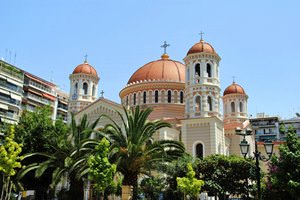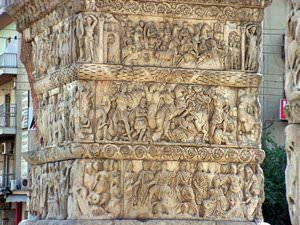 The fist settlement on the territory of the modern city of Thessaloniki was established as far back as in prehistoric age. This fact is proven with archeological findings of current digs. The Archeological Museum of Thessaloniki offers its guests a priceless collection of showpieces aged several thousand years. The main showpieces of its collection are considered to be the wealth and jewels of Macedonian King Phillipos II which were discovered by archeologists during the dig in Vergina. Tourists will find among the showpieces of the museum collection household items, gold ware and ancient sculptures.
The fist settlement on the territory of the modern city of Thessaloniki was established as far back as in prehistoric age. This fact is proven with archeological findings of current digs. The Archeological Museum of Thessaloniki offers its guests a priceless collection of showpieces aged several thousand years. The main showpieces of its collection are considered to be the wealth and jewels of Macedonian King Phillipos II which were discovered by archeologists during the dig in Vergina. Tourists will find among the showpieces of the museum collection household items, gold ware and ancient sculptures.
Thessaloniki is considered to be a youth resort as the city boasts a plenty of bright night clubs and dance floors, brand boutiques and upscale restaurants. The city offers an excellent …  Open
Open
1. Tourist can choose either public bus or a taxi to cruise the city. The taxi service features rather attractive prices. The taxi will be the most profitable way to explore the city for …  Open
Open
City tours, excursions and tickets in Thessaloniki and surroundings
Plan your own excursion through Thessaloniki: churches, museums and castles
Church of Panagia Dexia, Thessaloniki
» The modern church was built in 1956. It replaced the Byzantium Hypatius’s Church.
» The facade of the religious building is decorated with columns placed near the central portal. The House of God is built of light blocks. The altar is faced with patterned tiles. Wall panels are covered with the bright art painting. It depicts saints and Biblical stories.
» Pilgrims are attracted by the Icon of the Kikk's Mother of God. It is also called the Merciful as the Virgin begs Christ for preserving the human race. There is a belief that the Holy Scripture made by the Evangelist Luke was blessed by the Mother of God. It is considered that it is her in-life portrait.
» The name of the church derives from Kykkos.
» The miraculous painting traveled a lot until it found refuge on the island of Cyprus. It had been in the Orthodox community in Egypt and in Constantinople.
» The picture depicts the Virgin holding the baby on the right (Dexia), which contradicts the tradition.
Rotunda of Galerius, Thessaloniki
Location on the map:  Facts:
Facts:
» Rotunda (“round” in Latin) is a cylinder building. The ancient temple has existed for 17 centuries. The House of God has been reconstructed many times. » The tower, the adjacent gallery with the entrance and columns, and the Imperial Palace of Galerius make a uniform complex.
» During the Byzantium reign, Rotunda was visited by Christians. When it was conquered by the Ottoman, the building had served as a mosque until 1912.
» The only minaret and the artificial water source for washing.
» According to the historical chronicles, the tower was built in 300. The huge building has a diameter of 24.5 m and is almost 30 m high. The monumental walls (6.3 m) served to protect the construction.
» In the upper walling, there are a lot of holes through which the air and daylight are provided.
» The mosaic has been preserved only in some inner rooms. You can see the saint with a halo in the central part of the dome.
» There is a gilded cross in the central entrance below the arched vault. It was allegedly made in the 4th-6th century.
» During excavations, the fan-shaped pedestal, from which sermons were pronounced, was found. The ambo was created in the 6th century.
Arch of Galerius, Thessaloniki
Location on the map:  Facts:
Facts:
» The Sasanid’s victory over the Persian Empire is represented by the monument in the form of the arch doorway. It was constructed upon the order of Emperor Galerius. » The triumphal construction date back to the late 3rd-early 4th century. The arch linked galleries that led to the mausoleum and the palace.
» There are embossed scenes of battles on all the walls of the brick pedestal. Wide panels of the four-tier canvasses depict the great defeat of the enemy.
» Canvasses are separated from each other by a chain decorated with flowers and leaves. The upper cornice is decorated with sculptural chamomiles.
» The solid molded picture depicts figures with improper proportions, for example, horses look smaller than riders. This style is called “narrative composition”.
» According to the inscriptions, the sculpture was created by Greek masters.
» It depicts battles, forgiven captives, and parts of city constructions. Figurines of elephants and camels represent battles held in the East.
» The preserved part of the wall is 29 m long.
» The arch of the early Christian and Byzantium architectural style gained the status of the guarded cultural object.




